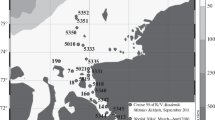Abstract
Lipopolysaccharide (LPS) concentrations, an indicator of bacterial biomass, were determined in the South China Sea and the Pacific Ocean. The distribution patterns of LPS were compared with those of chlorophyll a (Chl a), zooplankton biomass and the concentrations of several nutrients. LPS and total bacterial numbers in seawater were correlated with each other with a correlation coefficient (r) of 0.84 at Stations 7, 8 and 10. Diurnal fluctuation of LPS was negligible, but Chl a varied slightly in the vertical water column. Zooplankton stayed at a depth of around 400 m during the daytime and ascended quickly to the surface (0–50 m) early in the evening. The profiles of LPS and Chl a were negatively correlated to each other in the water layers above the Chl a maximum peak (r=-0.74; excluding the samples from 75 m at Station 7 and 10 m at Station 11 due to inadequate data for the statistical analysis). LPS and zooplankton biomass during the night-time, in contrast, paralleled each other at 5 stations surveyed (r=0.71). The presence of zooplankton resulted in an increase in bacterial numbers in the seawater in vitro. Based on these results, the factors controlling the occurrence and abundance of bacteria and phyto- and zooplankton in the pelagic sea are discussed.
Similar content being viewed by others
Literature cited
Berk, S. G., D. C. Brownlee, D. R. Heinle, H. J. Kling and R. R. Colwell: Ciliates as a food source for marine planktonic copepods. Microbial. Ecol. 4, 27–40 (1977)
Heinle, D. R., R. P. Harris, J. F. Ustach and D. A. Flemer: Detritus as food for estuarine copepods. Mar. Biol. 40, 341–353 (1977)
Hobbie, J. E., R. J. Daley and S. Jasper: Use of nuclepore filters for counting bacteria by fluorescence microscopy. Appl. environ. Microbiol. 33, 1225–1228 (1977)
Honjo, S. and M. R. Roman: Marine copepod fecal pellets: production, preservation and sedimentation. J. mar. Res. 36, 45–57 (1978)
King, K. R., J. T. Hollibaugh and F. Azam: Predator-prey interactions between the larvacean Oikopleura dioica and bacterio-plankton in enclosed water columns. Mar. Biol. 56, 49–57 (1980)
Levin, J. and F. B. Bang: The role of endotoxin in the extracellular coagulation of Limulus blood. Bull. Johns Hopkins Hosp. 115, 265–274 (1964)
Maeda, M.: Determination of bacterial biomass in seawater and its significance. In: Ecology of microorganisms, No. 10, pp 33–44. Ed. by Japanese Society of Microbial Ecology. Tokyo: Gakkai Shuppan 1982 (in Japanese)
Maeda, M. and N. Taga: Chromogenic assay method of lipopolysaccharide (LPS) for evaluating bacterial standing crop in seawater. J. appl. Bacteriol. 47, 175–182 (1979)
Maeda, M. and N. Taga: Comparisons of cell size of bacteria from four marine localities. La Mer (in press)
McMahon, J. W. and F. H. Rigler: Feeding rate of Daphnia magna Straus in different foods labeled with radioactive phosphorus. Limnol. Oceanogr. 10, 105–113 (1965)
Murphy, J. and J. P. Riley: A modified single solution method for the determination of phosphate in natural waters. Anal. chim. Acta 27, 31–36 (1962)
Paffenhöfer, G. A. and J. D. H. Strickland: A note on the feeding of Calanus helgolandicus on detritus. Mar. Biol. 5, 97–99 (1970)
Porter, K. G., M. L. Pace and J. C. Battey: Ciliate protozoans as links in freshwater planktonic food chains. Nature, Lond. 277, 563–565 (1979)
SCOR/UNESCO: Determination of photosynthetic pigments in seawater: In: Monographs on oceanographic methodology, No. 1, 69 pp. Paris: UNESCO 1966
Seki, H.: Studies on microbial participation to food cycle in the sea III. Trial cultivation of brine shrimp to adult in a chemostat (1). J. Oceanogr. Soc. Japan 22, 105–110 (1966)
Sharp, J. H.: Improved analysis for “particulate” organic carbon and nitrogen from seawater. Limnol. Oceanogr. 19, 984–989 (1974)
Wood, E. D., F. A. Armstrong and F. A. Richards: Determination of nitrate in sea water by cadmium-copper reduction to nitrite. J. mar. biol. Assoc., U.K. 47, 23–31 (1967)
Zimmermann, R. and L. A. Meyer-Reil: A new method for fluorescence staining of bacterial populations on membrane filters. Kiel. Meeresforsch. 30, 24–27 (1974)
Author information
Authors and Affiliations
Additional information
Communicated by M. Anraku, Hiroshima
until December, 1983. After January, 1984 to the Ocean Research Institute
Rights and permissions
About this article
Cite this article
Maeda, M., Lee, W.J. & Taga, N. Distribution of lipopolysaccharide, an indicator of bacterial biomass, in subtropical areas of the sea. Marine Biology 76, 257–262 (1983). https://doi.org/10.1007/BF00393026
Accepted:
Issue Date:
DOI: https://doi.org/10.1007/BF00393026




